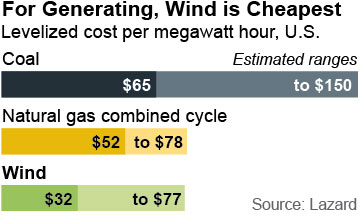Ohio Ratepayers Get Short Shrift in State’s Refusal to Embrace Renewables and Efficiency Programs

 Reinstating Ohio’s renewable energy and energy efficiency standards would result in billions of dollars of savings for Ohio ratepayers through 2030. That’s the conclusion of a new Wind Energy Foundation study formally reviewed by IEEFA.
Reinstating Ohio’s renewable energy and energy efficiency standards would result in billions of dollars of savings for Ohio ratepayers through 2030. That’s the conclusion of a new Wind Energy Foundation study formally reviewed by IEEFA.
Among the study’s major findings:
- Ohio lawmakers would save Ohio electricity ratepayers over $3 billion by 2030 by ending the state’s freeze on renewable and efficiency standards this year.
- Time is of the essence. Ohio can take maximum advantage of the federal wind production tax credit—set to decline through 2019—by lifting the freeze now.
- The state would do be doing right Ohioans by reforming its wind-turbine setback law, which is the most severe in the country and which is inhibiting the development of in-state wind energy.
In 2008, Ohio enacted energy-development standards that required utilities to source a growing percentage of their power from renewable sources and from efficiency programs. However, in 2014, the standards were frozen under pressure from some of the state’s electric utilities, led by FirstEnergy. The upshot today is that that the state’s utilities aren’t required to expand efficiency or renewables programs beyond what they had in 2014. The standards are scheduled to go back into effect in 2017 unless the freeze is extended by the Legislature, which is actively considering a bill to extend the freeze.
In lobbying against Ohio’s renewable energy and efficiency standards, FirstEnergy has argued that such policies distort the free market. This is a deeply ironic assertion from a company whose proposal for a power purchase agreement to bail out its struggling coal and nuclear power plants (to the tune of $4 billion over the next eight years) was just stalled by the Federal Energy Regulatory Commission precisely because it would interfere with Ohio’s deregulated electricity market. For all its rhetoric about free markets, it’s clear that FirstEnergy and its allies in state government are really only interested in protecting the profitability of FirstEnergy power plants.
And FirstEnergy’s work against renewable energy and efficiency as well as its bailout campaign for its old power plants conflict with the company’s latest public relations campaign. In its “Switch2Green4Free” advertising blitz the company is promoting 100 percent wind-generated electricity to the first 1,000 Ohio customers who sign up for it. It amounts to little more than window dressing, however, and translates output-wise into about what two or three wind turbines would produce.
One of the key points of the Wind Energy Foundation study is that, thanks to recent price declines, wind energy is now among the lowest-cost sources of electricity generation. Ohio’s Blue Creek Wind Farm, which we detailed in a commentary here last year, shows how investing in wind saves money for Ohio municipalities. And the study points out that replacing FirstEnergy’s proposed power purchase agreement with wind energy would result in substantial savings to ratepayers.
FirstEnergy’s entrenched opposition to the Buckeye State’s renewable and energy-efficiency standards shows exactly why such standards are needed: to ensure that Ohio ratepayers have access to low-cost power sources, even if those aren’t the most profitable sources for Ohio’s incumbent utilities.
Cathy Kunkel is an IEEFA energy analyst.
Related posts:
FirstEnergy Brings Its Bailout Show Back to West Virginia
Op-Ed: The Moral Case for Reinstating Ohio’s Renewable Energy Standards
Ruling Is a Giveaway to FirstEnergy and AEP, and a Betrayal of Ratepayers











